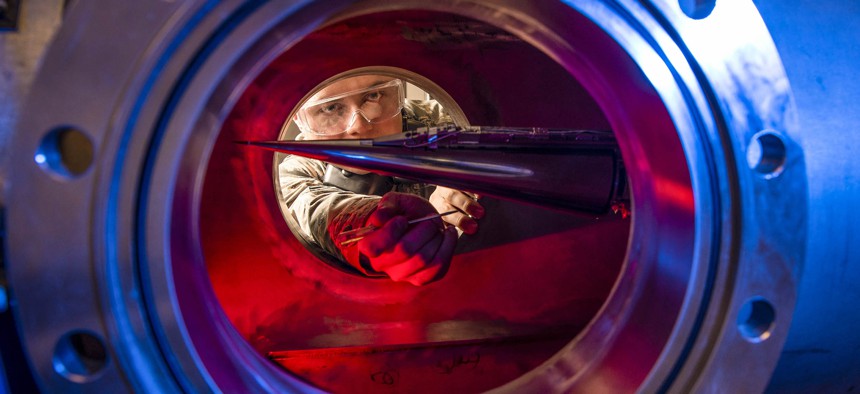
Air Force Cadet 2nd Class Eric Hembling uses a Ludwieg tube, a type of wind tunnel, to measure the pressures, temperatures and flow fields of basic geometric and hypersonic research vehicles at the U.S. Air Force Academy in Colorado Springs, Colo., Jan. 31, 2019. U.S. Air Force / Joshua Armstrong
Why Do US Hypersonic Missile Tests Keep Failing? They’re Going Too Fast
If it’s so important to deploy these new missile types, development schedules should be revised to promote success.
A new arms technology is coming into its own, and the U.S. Defense Department is determined to achieve quick results in the field. Rather than select one or two concepts and usher them through the deliberate, highly structured process of research, development, testing, and evaluation, the Pentagon’s program managers opt for multiple, competing efforts, and place them on a streamlined course: rapid prototyping and testing, to be followed by rapid production and deployment. The major defense contractors set forth as confidently as prospectors during the gold rush.
The trouble is, the new weapons keep failing in tests, sometimes in fairly rudimentary ways that don’t lend themselves to evaluating and improving the design. The truncated development strategy seems to require a faith that American aerospace engineering can overwhelm all the usual difficulties by force of sheer élan. The results turn out differently.
Now, if you think I’ve just described the last few years of U.S. efforts to build and fly hypersonic gliders and cruise missiles, you’re right. In December, for example, the Air Force’s Air-Launched Rapid Response Weapon (ARRW) failed in testing for the third time running in 2021, not even leaving the wing of the B-52 bomber carrying it. ARRW, remarkably, is supposed to become an operational weapon by 2023. Nor is it the only developmental hypersonic missile with a troubled test record.
But I could just as easily have been recalling U.S. efforts to build new ballistic missile defense systems in the 1990s. It’s little remembered now, but BMD got off to a rocky start. After repeated disappointments, a trio of Pentagon agencies did something perhaps uncharacteristically forward-looking: it assembled a panel of seasoned experts to examine the situation, under the leadership of retired Air Force general Larry Welch. It even allowed the panel’s reports to be released to the public.
The first report of the Welch Panel made something of a splash at the time. It’s worth recalling its frank account of the self-defeating nature of short timetables in complex technology development efforts:
“These programs are pursuing very aggressive schedules, but these schedules are not supported by the state of planning and testing…the perceived urgency of the need for these systems has led to high levels of risk that have resulted in delayed deployments…
“[Failures] were caused by poor design, test planning, and preflight testing deficiencies; poor fabrication; poor management; and lack of rigorous government oversight.
“The tendency of the government and program managers to trivialize the causes of these costly failures, combined with the aggressive schedule… has led to a ‘rush to failure.’”
The report’s main recommendation—to put all BMD programs on “realistic schedules”—met with some predictable resistance, and we can’t be sure how much influence any single report or expert panel may have had. But it was surely vindicated after one of the most troubled BMD efforts shifted to a longer timeline. Prototypes of the THAAD system had produced four consecutive failures in hit-to-kill intercept tests by the time of the first Welch report in February 1998. After another two out of four test failures by August 1999, the program entered a new phase of development. Flight tests did not resume until 2005, but have yielded consistent successes since then—at least when the target missile has not failed. The first operational THAAD battery, originally scheduled to deploy in 1996, appeared in 2008.
We also don’t know if all of the Welch Panel’s judgments about the shortcomings of missile defense systems under development in the 1990s would apply equally to today’s hypersonic weapons projects. But an April 2021 report from Congress’s Government Accountability Office sounds some unhappily familiar notes.
Most of the efforts to develop these new missiles, GAO found, use a new development authority that bypasses regular DOD “acquisition and requirement development policies and processes.” These projects aim at building an initial prototype within six months and deploying an initial capability within five years. Among the many problems facing the development of hypersonic missiles, GAO noted, were “immature technologies and aggressive schedules.”
The lesson should be clear: if it’s genuinely important to deploy these new missile types, the Pentagon should adopt development schedules conducive to their success. If it won’t do so, Congress should ask what drives it to repeat the errors of the past.
NEXT STORY: 2021 Top Ten: Ideas



